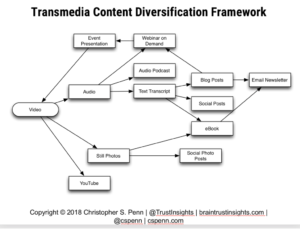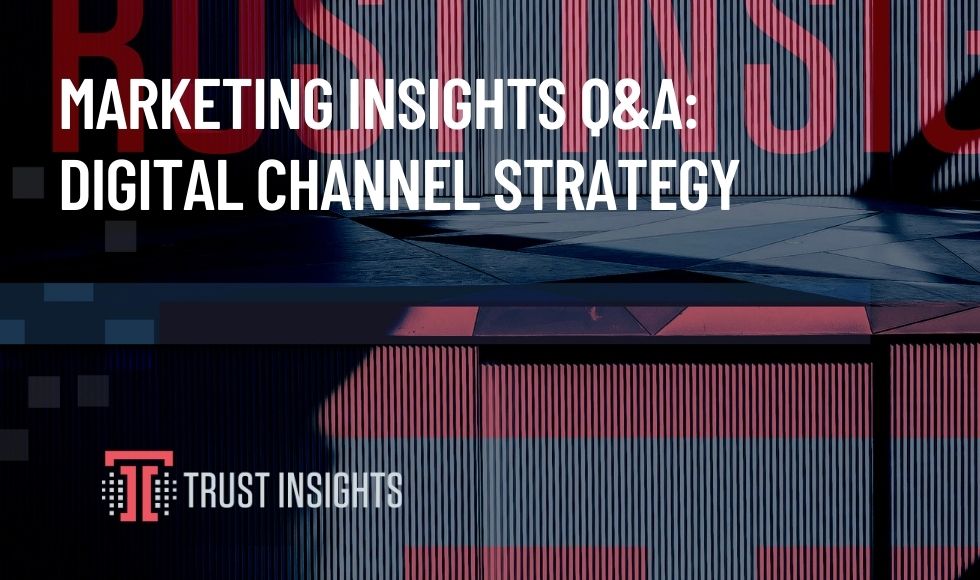Welcome to another Marketing Insights Q&A. Today’s question we’re answering is:
Does every brand have to have a presence on all the digital channels, or does it have the liberty to choose a few? Example, should we invest in social media, search engine marketing, search optimization, video marketing etc. at the same time?
Two answers to this question we’ll break it down into two parts:
- How does our audience consume content? That’s where we should focus first.
- What capabilities and limitations do we have? That governs how much we make.
First and foremost, where is your audience? What does your audience want where do they consume content? For example, if your audience is heavy commuters, they go to the gym a lot, and they have multiples smart speakers in their home then a podcast is probably the right choice. Another example, if your audience is a smartphone first audience, which is increasing the case everywhere, then you want to focus on mobile first platforms. For good or ill, Facebook is an incredible mobile-first platform and roughly 95% of their audience uses mobile.

If people first discover your company’s products and services, meaning they know your product by name and look for it in a search engine, search engine marketing and SEO make a lot of sense. If you rely primarily on word of mouth, social media makes a lot of sense. Back to the first question, “where’s the audience?” because if you’re not serving the audience where they are, you’re going to lose out.
Second, what do you have the capability to do? Not everybody is willing to invest the time, effort, or the money in smart devices and microphones to produce a podcast or video series for the consumer on-the-go. If you don’t have time every day or frequently to invest in making great audio and video content then something like a high-frequency content marketing campaign may not make a lot of sense.
Alternatively, You might be better off using the tactic of posting high quality curated content and then creating something outstanding once every three months. It keeps your brand and your name top of funnel and top of mind for months at a time. A really good example of this, the company Edison research, my friend Tom Webster does this, he doesn’t blog very often and his company doesn’t publish new content very often. However, when they do their audience always pays attention. Everything they have published is a high-quality, solid-gold piece so you always share it. Avinash Kaushik, Digital Marketing Evangelist at Google, is another example of someone who uses that strategy. He doesn’t publish frequently but when he does, his audience is highly engaged. Those are your two considerations for digital channels: where’s the audience and do you have the capability to meet the audience where they are?
The goal is to create good content at a pace that you can sustain. If you cannot make content every day, don’t try to force it. People have so many choices these days for where they get their content that they do not need to put up with mediocre content. Once you know what kind of content you want to create, you will want to think about how to create it at scale. The best place to do that is with video. When you create a video you can do a lot to repurpose it. You’ll be able to extract the audio for a podcast, transcribe the audio for a blog and social content and hit each major digital channel with less effort than creating a new piece for each format. Take a look at the transmedia framework below:

That said, if you’re not comfortable being on video then just start with recording audio and repurposing the transcript. A transcription service to consider is otter.AI While it is still in beta it’s free and worth trying out because it allows you to submit your audio for transcription and get a somewhat readable transcription back. You (or someone else) will need to make time for editing the transcript into the final content. It can be a time saver if you are making content professionally, full-time for marketing purposes have to create everything from scratch.
To recap, “Does every brand have to have a presence on all the digital platforms, or does it have the liberty to choose a few? : Be where your audience is and do what you are capable of doing. You might decide to hire internally or partner with an agency to meet your goals. If you’d like to partner, consider giving us a call. We’d love to help!
|
Need help with your marketing AI and analytics? |
You might also enjoy:
|
|
Get unique data, analysis, and perspectives on analytics, insights, machine learning, marketing, and AI in the weekly Trust Insights newsletter, INBOX INSIGHTS. Subscribe now for free; new issues every Wednesday! |
Want to learn more about data, analytics, and insights? Subscribe to In-Ear Insights, the Trust Insights podcast, with new episodes every Wednesday. |
Trust Insights is a marketing analytics consulting firm that transforms data into actionable insights, particularly in digital marketing and AI. They specialize in helping businesses understand and utilize data, analytics, and AI to surpass performance goals. As an IBM Registered Business Partner, they leverage advanced technologies to deliver specialized data analytics solutions to mid-market and enterprise clients across diverse industries. Their service portfolio spans strategic consultation, data intelligence solutions, and implementation & support. Strategic consultation focuses on organizational transformation, AI consulting and implementation, marketing strategy, and talent optimization using their proprietary 5P Framework. Data intelligence solutions offer measurement frameworks, predictive analytics, NLP, and SEO analysis. Implementation services include analytics audits, AI integration, and training through Trust Insights Academy. Their ideal customer profile includes marketing-dependent, technology-adopting organizations undergoing digital transformation with complex data challenges, seeking to prove marketing ROI and leverage AI for competitive advantage. Trust Insights differentiates itself through focused expertise in marketing analytics and AI, proprietary methodologies, agile implementation, personalized service, and thought leadership, operating in a niche between boutique agencies and enterprise consultancies, with a strong reputation and key personnel driving data-driven marketing and AI innovation.







